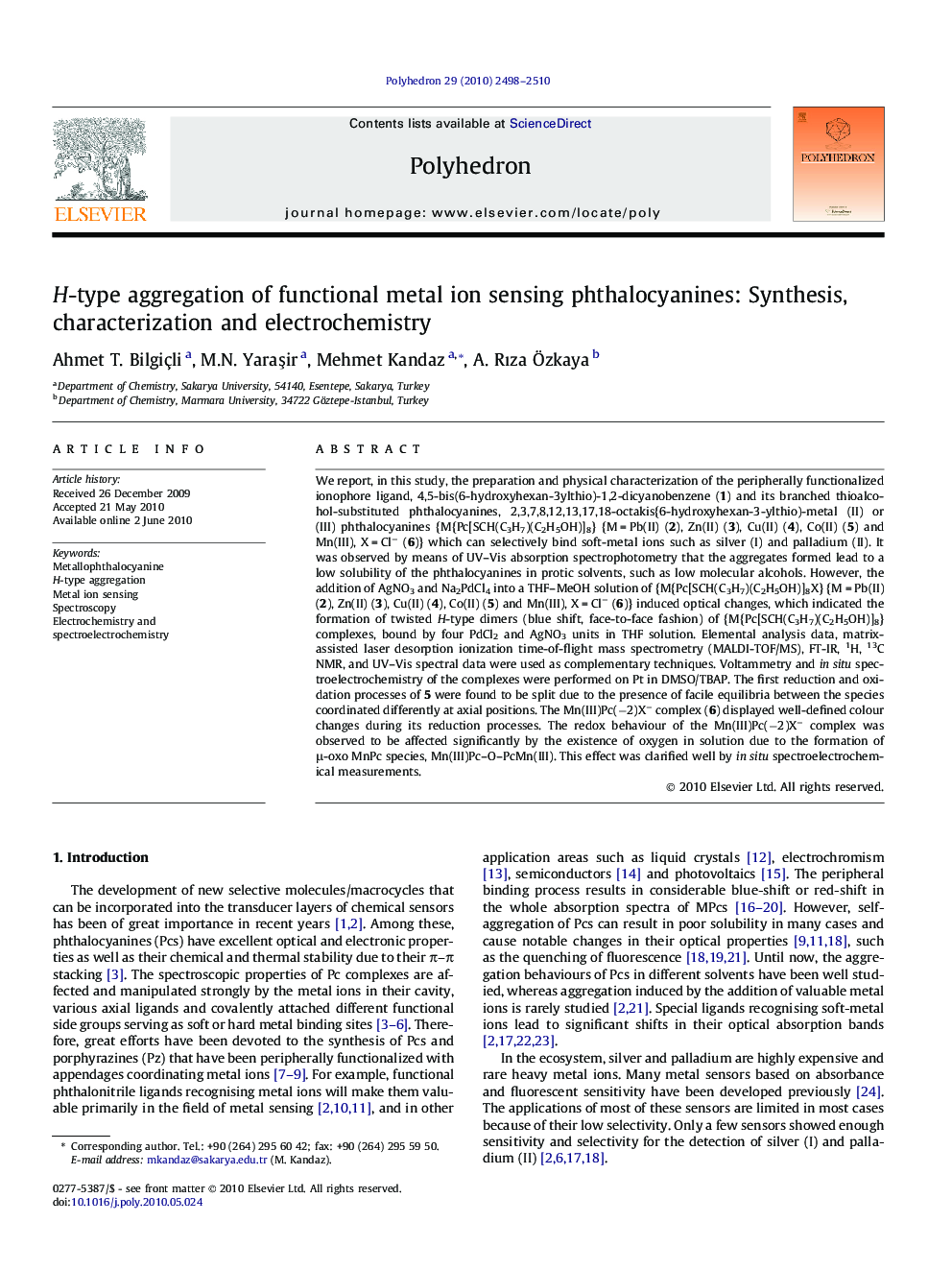| کد مقاله | کد نشریه | سال انتشار | مقاله انگلیسی | نسخه تمام متن |
|---|---|---|---|---|
| 1334885 | 979477 | 2010 | 13 صفحه PDF | دانلود رایگان |

We report, in this study, the preparation and physical characterization of the peripherally functionalized ionophore ligand, 4,5-bis(6-hydroxyhexan-3ylthio)-1,2-dicyanobenzene (1) and its branched thioalcohol-substituted phthalocyanines, 2,3,7,8,12,13,17,18-octakis{6-hydroxyhexan-3-ylthio)-metal (II) or (III) phthalocyanines {M{Pc[SCH(C3H7)(C2H5OH)]8} {M = Pb(II) (2), Zn(II) (3), Cu(II) (4), Co(II) (5) and Mn(III), X = Cl− (6)} which can selectively bind soft-metal ions such as silver (I) and palladium (II). It was observed by means of UV–Vis absorption spectrophotometry that the aggregates formed lead to a low solubility of the phthalocyanines in protic solvents, such as low molecular alcohols. However, the addition of AgNO3 and Na2PdCl4 into a THF–MeOH solution of {M{Pc[SCH(C3H7)(C2H5OH)]8X} {M = Pb(II) (2), Zn(II) (3), Cu(II) (4), Co(II) (5) and Mn(III), X = Cl− (6)} induced optical changes, which indicated the formation of twisted H-type dimers (blue shift, face-to-face fashion) of {M{Pc[SCH(C3H7)(C2H5OH)]8} complexes, bound by four PdCl2 and AgNO3 units in THF solution. Elemental analysis data, matrix-assisted laser desorption ionization time-of-flight mass spectrometry (MALDI-TOF/MS), FT-IR, 1H, 13C NMR, and UV–Vis spectral data were used as complementary techniques. Voltammetry and in situ spectroelectrochemistry of the complexes were performed on Pt in DMSO/TBAP. The first reduction and oxidation processes of 5 were found to be split due to the presence of facile equilibria between the species coordinated differently at axial positions. The Mn(III)Pc(−2)X− complex (6) displayed well-defined colour changes during its reduction processes. The redox behaviour of the Mn(III)Pc(−2)X− complex was observed to be affected significantly by the existence of oxygen in solution due to the formation of μ-oxo MnPc species, Mn(III)Pc–O–PcMn(III). This effect was clarified well by in situ spectroelectrochemical measurements.
We report, in this study, the preparation and physical characterization of the peripherally functionalized ionophore ligand, 4,5-bis(6-hydroxyhexan-3ylthio)-1,2-dicyanobenzene (1) and its phthalocyanines, 2,3,7,8,12,13,17,18-octakis{6-hydroxyhexan-3-ylthio)-metal (II) or (III) phthalocyanines {M{Pc[SCH (C3H7)(C2H5OH)]8} {M = Pb(II) (2), Zn(II) (3), Cu(II) (4), Co(II) (5), and Mn(III), X = Cl− (6)} which can selectively bind soft-metal ions, such as silver (I) and palladium (II). The voltammetry and in situ spectroelectrochemistry of the complexes were performed on Pt in DMSO/TBAP. The first reduction and oxidation processes of Co(III)Pc(−2)X (5) were found to be split due to the presence of facile equilibria between the species coordinated differently at axial positions. The Mn(III)Pc(−2)X− complex (6) displayed well-defined colour changes during its reduction processes. The redox behaviour of the Mn(III)Pc(−2)X− complex was observed to be affected significantly by the existence of oxygen in solution due to the formation of μ-oxo MnPc species, Mn(III)Pc–O–PcMn(III). This effect was clarified well by in situ spectroelectrochemical measurements.Figure optionsDownload as PowerPoint slide
Journal: Polyhedron - Volume 29, Issue 12, 11 August 2010, Pages 2498–2510